Apr
13
2010
or Tablets of Flesh

Keith Mathison writes:
“…apocalyptic literature was oriented toward the future and expressed its message in vivid symbolism encoded in dreams and visions. It is a genre of revelatory literature with a narrative framework, in which a revelation is mediated by an otherworldly being to a human recipient, disclosing transcendent reality.” [1]
Although this statement from Mathison’s helpful book is true, the more I learn the more I tend to believe our genre classification leaves a lot to be desired. The Bible is more organic than that.
Continue reading
Comments Off | tags: Apocalyptic, Keith Mathison, Tabernacle | posted in Biblical Theology
Apr
2
2010

In Jesus’ seven words, He fulfills not only Israel’s feasts and the Tabernacle, but makes all Creation new.
Continue reading
3 comments | tags: Crucifixion, Feasts, Tabernacle | posted in Biblical Theology
Mar
24
2010
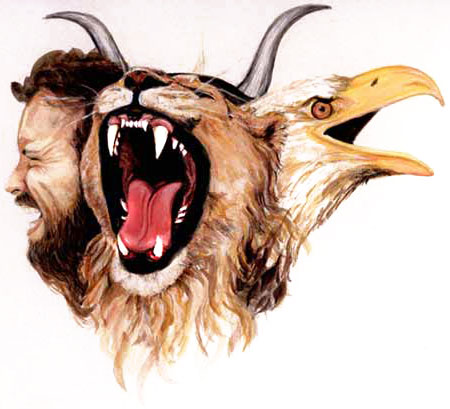
Most commentators, including N. T. Wright, get the Restoration era all wrong. Our history as God’s people is cruciform, which is reflected in the four faces of the cherubim. The Mosaic “bull face” (the Bronze Altar) was replaced with the Davidic “lion face” (the Ark). The Ark was taken by God, and the era of the prophets began, the “eagle face” (the all-seeing Lampstand). Resurrected Israel was to be wise men to Gentile kings, leaven within the kingdoms shown to Nebuchadnezzar. They would not have a Jewish king until the fourth face, the Man, arrived (the Table of Showbread).
Continue reading
1 comment | tags: Esther, Haman, James Jordan, Tabernacle | posted in Quotes, The Restoration Era
Mar
20
2010
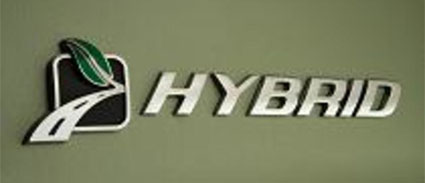
or Animal, Vegetable, Mineral
There’s some weird stuff in Leviticus. It is deliberately so, forcing us to chew on it, which in turn forces us to see the world in terms of symbols, as God intended. Most of us moderns can’t be bothered with it. It’s beyond our capacity. We think such notions are childish when in fact they require an uncommon wisdom.
Continue reading
4 comments | tags: High Priest, James Jordan, Leviticus, Tabernacle, Typology | posted in Biblical Theology, Quotes
Mar
18
2010
Memorials are a big deal in the Bible. When the Lord sees a covering—a firmament—whether it be a rainbow, or blood displayed, He remembers.
When Jesus asks His disciples to perform the Lord’s supper as a memorial to Him, it is not for our memory but God’s. He sees the bread and wine, remembers the blood of His son, and we are spared, covered.
Continue reading
Comments Off | tags: Baptism, Crucifixion, Feasts, Luke, Memorial, Tabernacle | posted in Biblical Theology
Mar
16
2010
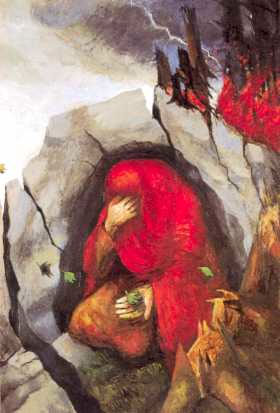
or Sinai Unspoken
On Mount Carmel, Elijah had built an altar of 12 rough-hewn stones. They substituted for the tribes of Israel. They were built and then consumed. The priests of Baal were slain and “washed” in the brook as atonement. The Land was clean. But we know Jezebel trampled this sacrifice underfoot. [1]
Elijah headed for the wilderness. He was a man with a mission. He went to the same cave in which Moses stood, a cleft in the rock. Once again, the Lord “passed over.” He was making a new Covenant, a new Creation, a new Heavens and a new Land.
Continue reading
Comments Off | tags: Azal, Cain, Elijah, Elisha, Ezekiel, Feasts, Hebrew, Jezebel, Tabernacle | posted in Biblical Theology, The Restoration Era
Mar
15
2010
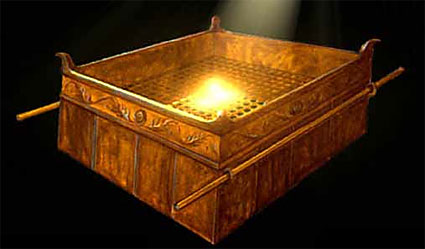
Okay, so The Earth is Flat after all. The Atlar’s being a symbol of the mediatorial Land, (a priesthood between the heavenly sky and Gentile sea) is the key to a fair amount of weird stuff in the Bible. It also means that a lot of what goes on in the Torah is the key to understanding some later enigmatic events.
The Bronze Altar had a grate inside it to support the sacrifice. The ashes would fall through the holes in the grate and the smoke would rise as a pleasing aroma to God.
In Numbers 16, concerning the rebellion of Korah and his sons, after the “censer” showdown between them and Aaron, the ground opened up and swallowed their tents, all their belongings and their families. However, fire consumed the wannabe priests who were offering the “false” incense. Even the rebellion was divided according to the priestly divisions within Israel. Ashes and smoke. [1]
Continue reading
Comments Off | tags: Aaron, Crucifixion, Korah, Liturgy, Revelation, Tabernacle, Zechariah | posted in Biblical Theology, The Last Days
Mar
13
2010
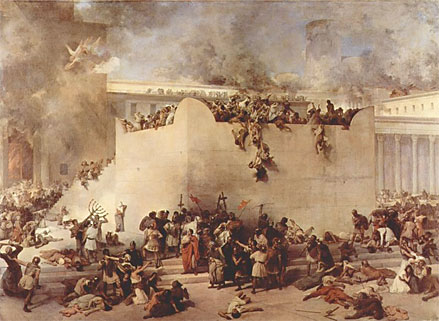
Understanding the “Trinity” of the Bible’s Garden, Land, World architecture is one of the most helpful keys to making sense of the prophets, Matthew 24 and the Revelation. [1] James Jordan writes:
“The Bible repeatedly speaks of the ‘ends’ of the earth. Sometimes the word in Hebrew is ephes, which means ‘end, extreme limits, nothingness.’ Other times it is qatsah or qetsev, which means, again, ‘end, extremity.’ Deuteronomy 13:7, for instance, uses the expression ‘from one end of the earth to the other end.’ Continue reading
Comments Off | tags: James Jordan, Tabernacle | posted in Biblical Theology, The Last Days
Feb
24
2010
or Meat to Eat – 1
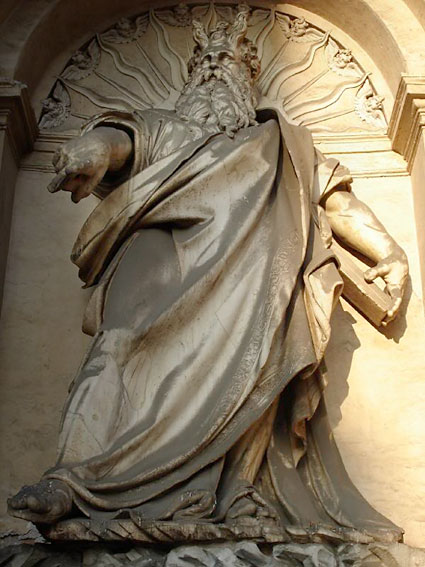
“And whanne Moises cam doun fro the hil of Synai, he helde twei tablis of witnessyng, and he wiste not that his face was horned of the felouschipe of Goddis word..” —Exodus 34:29, Wycliffe
Perhaps you’ve seen those bumper stickers that say, “If we’re not meant to eat animals, why are they made of meat?”
NOTE: THIS POST HAS BEEN REMIXED AND INCLUDED IN GOD’S KITCHEN.
You must be logged in to see the rest of this post.
Join now for a year for $15!
From memory, men didn’t eat meat until after the flood. The history from Adam to Noah follows the Feasts pattern, with Adam as the Alpha male (heh) and Noah as the mature and wise Omega male of that initial process. [1] Moving from vegetarianism (literally “seeds”) to meat was not only a sign of judgment, but a sign of greater judgment put into the hands of God’s Man. [2] Noah could eat meat, and he could also sentence murderers to death. Man now had teeth in a way he had never had them before. Even we use the phrase “toothless” to refer to ineffective pieces of legislation. As mentioned elsewhere here, teeth and tusks and ivory and horns are symbols of justice, whether they be on men, animals, or altars. [3] A blood-covered horn means the crime is atoned for. Just as Christ was a Lamb with seven horns, worthy to open the scroll, Moses came down from Sinai with not only a “scroll” (or tablets in that case) but “horns.” This translation has been dismissed as errant, but perhaps the reason for it should not be dismissed so easily. Here’s my attempt at an interpretation.
Continue reading
Comments Off | tags: Adam, Exodus, Incense Altar, Ivory, Moses, Noah, Tabernacle, Vegetarianism | posted in Biblical Theology, Creation
Feb
19
2010
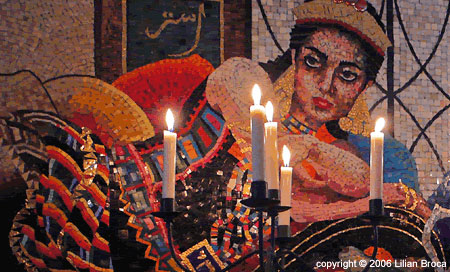
or Smells Like Holy Spirit
A friend recently gave me a unique gift. With some difficulty and great expense, he sourced the ingredients for the anointing oil of the Aaronic priesthood and I was the grateful recipient of a small, blue vial.
The scent of the oil is intoxicating. You breathe it in and in some strange way you can “taste” it as it goes down. It is extremely complex and yet a single fragrance. Continue reading
Comments Off | tags: Ark of the Covenant, Atonement, Covenant Theology, Creation Week, David, Esther, Ezekiel, Genesis, Greater Eve, Incense Altar, James Jordan, Peter Leithart, Resurrection, Saul, Tabernacle | posted in Biblical Theology, Quotes, The Last Days, The Restoration Era


































